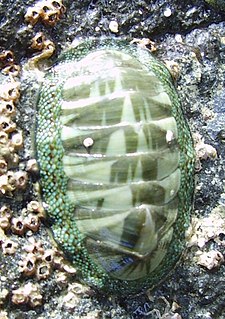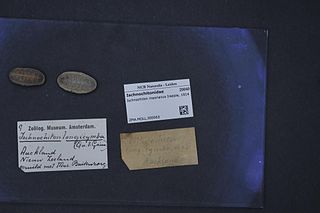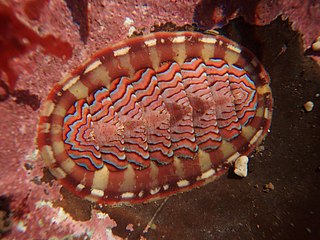
The gumboot chiton also known as the giant western fiery chiton, is the largest of the chitons, growing to 36 cm (14 in) and over 2 kg (4.4 lb). It is found along the shores of the northern Pacific Ocean from Central California to Alaska, across the Aleutian Islands to the Kamchatka Peninsula and south to Japan. It inhabits the lower intertidal and subtidal zones of rocky coastlines.

Eudoxochiton nobilis, commonly called the noble chiton, is a large chiton of the family Callochitonidae. Māori name is Rangitīra.

Chiton glaucus, common name the green chiton or the blue green chiton, is a species of chiton, a marine polyplacophoran mollusk in the family Chitonidae, the typical chitons. It is the most common chiton species in New Zealand. Chiton glaucus is part of a very primitive group of mollusc with evidence of being present in up to 80 million years of the fossil record.

Cryptoconchus porosus, the butterfly chiton, is a species of chiton, a marine polyplacophoran mollusc in the family Acanthochitonidae.

Ischnochiton maorianus, sometimes called the variable chiton, is a fast moving species of chiton in the family Ischnochitonidae, endemic to the main islands of New Zealand where it is abundant.

Sypharochiton pelliserpentis is a species of chiton in the family Chitonidae. As the species name suggests, the surface of the girdle in this chiton has a pattern of overlaying scales resembling snakeskin.

Acanthochitona zelandica is a species of chiton in the family Acanthochitonidae, also sometimes known as the hairy, or "tufted," chiton. It probably developed during the mid to late Pleistocene, and is endemic to New Zealand.

Tonicella lineata, commonly known as the lined chiton, is a species of chiton from the North Pacific.

Tonicella lokii, commonly known as the flame lined chiton or Loki's chiton, is a chiton in the lined chiton genus Tonicella.

The hairy chiton is a species of chiton in the family Chaetopleuridae. It is a marine mollusc.
The orange hairy chiton, Chaetopleura pertusa, is a species of chitons in the family Chaetopleuridae. It is a marine mollusc. It is endemic to South Africa.
Mopalia ciliata is a chiton in the genus Mopalia, commonly known as the hairy chiton. It is a medium-sized marine mollusc up to 5.0 cm in length. It is oval shaped with 8 separate moderately elevated, overlapping ridged valves on its dorsal surface. It resides along the coast of North America.

Chiton olivaceus, the green chiton, is a species of chiton, a marine polyplacophoran mollusk in the family Chitonidae, the typical chitons.
Plaxiphora boydeni is a small uncommon chiton in the family Mopaliidae, endemic to the East Coast of the South Island, New Zealand, Stewart Island and the Chatham and Subantarctic Islands.
Plaxiphora caelata is a small chiton in the family Mopaliidae, endemic to the main islands of New Zealand, Stewart Island and the Chatham Islands.
Plaxiphora egregia is a distinctive chiton in the family Mopaliidae, endemic to the South Island of New Zealand, where it is uncommon.

Plaxiphora biramosa is an uncommon chiton in the family Mopaliidae, endemic to New Zealand.

Plaxiphora obtecta is a large chiton in the family Mopaliidae, endemic to New Zealand, where it is most often found on the West Coast of the North Island. It is called Haka-hiwihiwi by some Māori and was likely a food source.

Callochiton dentatus, the broad chiton, is a medium to large-sized polyplacophoran mollusc in the family Callochitonidae, found on the coast of southern Africa.














